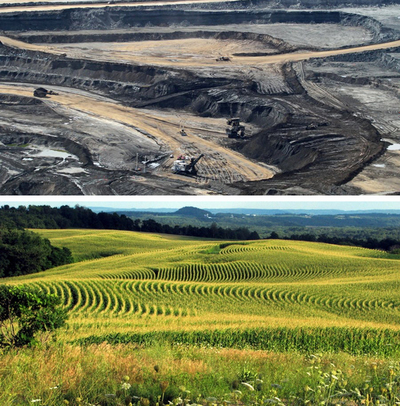The Standoff Between Truth and Lies - Ethanol vs Gasoline
A Response to David Gelles - THE STANDOFF BETWEEN BIG OIL AND BIG CORN - New York Times
By Marc J. Rauch
Exec. Vice President/Co-Publisher
THE AUTO CHANNEL
 Marc J. Rauch |
There's two extremely simple ways to determine whether the Renewable Fuel Standard/Renewable Fuels Mandate has been successful in addressing energy independence, environmental problems, and certain health issues. These two ways are so uncomplicated that anyone should be able to understand them, including PhD professors on the Big Oil dole.
But first, this piece of history:
The original fuel used in the original internal combustion engines was alcohol or an alcohol-turpentine mixture. The original fuel for the diesel engine was peanut oil. Notice that there's no mention of any petroleum oil fuels. Petroleum oil fuels came into prominence in the U.S. because of monstrous taxes on alcohol production for more than 40 years, which covered all the formative years of the creation of the automobile and automotive industry. The taxes simply priced alcohol (ethanol) out of market competition for nearly all users, except race teams, scientific experimentation, and engine designers.
The taxes were finally removed by an act of Congress in 1906, and for several years ethanol was competitively priced against gasoline. This new low price was meaningful enough that Henry Ford built the Model T to operate on either gasoline or ethanol (or kerosene). Unfortunately for an ethanol-fuel industry that was trying to grow and compete with the oil industry, another event took place that was even more disastrous than taxes to halt ethanol's climb up the acceptance and usage ladder in America: Prohibition - the outlawing of the manufacture of ethanol. And nothing kills competition like killing off the main competitor.
Gasoline and petroleum diesel didn't become our primary internal combustion engine (ICE) fuels because they were better fuels, but because they were cheaper and because they were available. There are great stories about how John Rockefeller and others made Prohibition happen to favor their Standard Oil Company, but for the moment we don't have to ponder this - The key thing is that Prohibition happened.
During this time, as technology progressed and consumers wanted better performance from their ICE vehicles, a conundrum arose - a conundrum wrapped in an incongruity. Advanced, high compression engines couldn't safely run on gasoline. The combustion knock in the engines due to gasoline's low octane was so severe it would destroy the engine. The only solution was to add an anti-knock ingredient to gasoline, and the only workable and affordable ingredient was ethanol - the substance that Rockefeller worked to make illegal.
The solution was to create a solution that could be added to gasoline in place of ethanol. The solution was found (invented) by General Motors top fuel scientists - scientists who had previously declared many times that ethanol was the fuel of the future. The invention was to add tetraethyl lead, a known poison, to gasoline. This created "leaded gasoline."
 Tale of Two Cemeteries - One filled with graves of those who died in oil wars versus one with no graves |
Now, gasoline by itself is poisonous. If you ingest it you'll die. The fumes could kill you. When you burn gasoline black soot is released into the atmosphere, and that can kill you or at least make you sick. The soot also forms deposits inside engines that then impedes the engine's performance. When they added tetraethyl lead poison to the gasoline poison they developed an illness bomb - an illness bomb that darkened our skies as if it presaged the ending of the world. But the darkened skies were more than just a fictional metaphor, the exhaust from leaded gasoline literally darkened our skies...and our lungs...and the insides of our engines.
This leads me to one of the two ways to simply know that the Renewable Fuel Standard/Renewable Fuel Mandate has been successful. All you have to do is look up. No, not "look it up," look up.
If you're in a large city that experienced great smog problems (such as New York, Los Angeles, San Francisco, Chicago, or overseas in London), and you look up on a cloudless day, you'll see blue. That blue is 'blue sky,' which represents clean or cleaner air. That blue sky is due in large part to the removal of tetraethyl lead from gasoline and to its replacement, ethanol.
The second simple way to determine if the RFS/RFM has been doing its job is through first grade mathematics. Remember 1+1=2? Remember 2-1=1? Okay, see if you can follow this: If you need, let's say, 7 billion barrels of oil per year, but you can substitute some of the oil with ethanol, then you need less oil per year. If you can get to the point where the oil industry stops lying about ethanol, so that the public no longer believes that petroleum oil fuels are needed, then we would have 7 billion barrels of oil minus 7 billion barrels of oil. To simplify the equation, 7-7=0. Zero means we don't need oil for fuel...not foreign oil, not domestic oil, no oil...no poisonous petroleum oil fuels to darken our skies, our lungs, our engines, our lives. No wars over oil, and far less money to fund terrorism.
To stop simple mathematics or a quick up-turn of one's head to look at the blue skies from getting the public (and politicians) to demand the removal of all petroleum oil fuels, the oil industry pays lots of people to invent more poison, like they did with leaded gasoline. However, this time the poison is in the form of "ink," as in "printing ink," as in media stories.
The people used by the oil industry often have impressive titles, and they often have well-known names. They invent preposterous scenarios that feature convoluted formulas that all boil down to lies and gross exaggerations. The lies are then enthusiastically presented by many media outlets either because of the potential for Big Oil advertising dollars, or a ravenous appetite for new content, or both. On some occasions the lies against ethanol are presented as just an attack on ethanol (and all alternative fuels), and sometimes the lies are masked in a story that feigns objectivity. The problem is that once you've besmirched someone's reputation with numerous (untrue) accounts of despicable behavior, it's not sufficient to quote a neighbor who says "He seemed like a nice boy to me," in order to balance out the objective story.
David Gelles' September 17th article in the New York Times surrounds the supposition presented in August by John DeCicco. The supposition is not new...not new for him, and not for other Big Oil shills. It's the same debunked, rebutted poison-pen information that David Pimentel and Tad Patzek tried to scam us on a decade ago. DeCicco tried this approach about a year ago and he was rebuffed. And DeCicco's August 2016 attempt is at least the fifth major attempt in the past few months in which Big Oil tried to ram the same basic set of lies down our throats (the other attempts were by Jillian Kay Melchor in January, George Banks in March, Daniel De La Torre Ugarte in June, and Jennifer A. Dlouhy in July).
The basic truth is that ethanol is a better fuel for internal combustion engines. It is cleaner, healthier, safer, cheaper, and it comes from domestic sources. Ethanol helps to clean the air, clean engines, provide domestic jobs, and end energy dependence on foreign regimes...almost all of whom are engaged in supporting international terrorism.
Originally published September 18, 2016
SEE ALSO:
-
Open Letter To Jillian Kay Melchor and National Review
Meet The New 'Tool' In Big Oil's Efforts To Scuttle Ethanol
Are Ethanol Opponents Sniffing Glue?
Biofuel Blunder? Renewable Fuel Mandate Is Having A Negative Effect on Home Run Totals
The Case Against Ethanol Opponents: They Are Simply Incorrect
It's Time To Rethink The Value Of PhD



